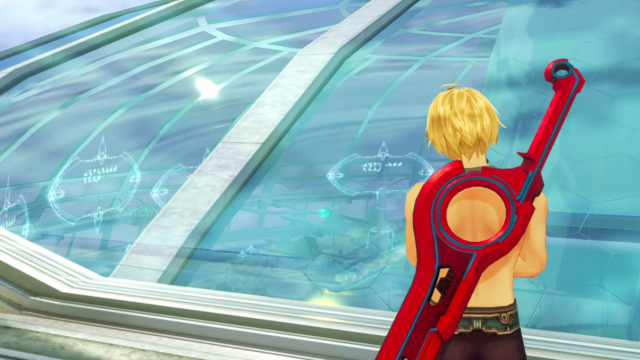Kotaku’s Mike Fahey put it best when he said that Xenoblade Chronicles: Definitive Edition “makes an excellent third impression.” As a newcomer to the series, I’d like to add to that: It makes an excellent first impression, as well.
Nintendo’s latest Switch game isn’t exactly full of surprises. Monolith Soft’s venerable role-playing game, spiritual successor to Xenogears and Xenosaga, first released stateside on the Wii in 2012. A few years later, it came to the New Nintendo 3DS. As of last week, it’s out on the Switch. For many, playing Xenoblade is less like trying out a brand-new cuisine and more like re-re-reordering that meal from that one place where you know it’ll hit the spot.
Not for me! Before last month, I only knew of Shulk, the main character, as a fun if overpowered fighter in Super Smash Bros. I’d also heard some horror stories about Xenoblade Chronicles: nigh-unmanageable inventories, a dull combat system, and, of course, the staggering amount of sidequest padding. But I’d also heard that the game world is lovely, the plot beats contain some genuine surprises, and the music—a must for any JRPG worth its salt—is truly best-in-class. This thing’s not considered a modern classic for nothing, right?
By and large, those preconceptions have borne true. And everything that’s upended expectations has been a positive. If you, like me, haven’t played Xenoblade Chronicles and want to see what it’s all about, then Definitive Edition is a great starting point.
The first thing you’ll note about Definitive Edition is how good it looks. Xenoblade Chronicles starts off with a simple story in a fascinating setting: In the opening cutscene, two gods, the Bionis and the Mechonis, fight to the death. Ages pass, and life starts popping up on their long-quiet bodies. There’s a war between two species: Homs (humans) and Mechon (machines…I think). You play as a young Homs named Shulk.
As you guide Shulk and his ragtag team of RPG party tropes on their quest for vengeance, it’s impossible not to stop and take in the sights. Everyone knows about the cliffs and crags (and sweeping soundtrack) of Gaur Plains. But that’s 101-level stuff. There’s no shortage of vistas in this game that will literally stop you in your tracks as you take a look around. For instance, Makna Forest’s waterfall, all due respect to the Iguazu Falls, puts any comparable earthly sight to shame. The utopian city of Alcamoth is essentially the dreams of a sci-fi set designer come to life. Even the starting city of Colony 9 engenders serious feelings of wanderlust. Comparing the Switch version to the original Wii’s 480p visuals only amplifies any appreciation.
To be sure, combat indeed starts off as somewhat of a drag. It’s frequently described as similar to combat in massively multiplayer online games. (I wouldn’t know. MMOs aren’t my thing.) Characters automatically perform basic attacks against any targeted enemy, so you could theoretically get away with allowing battles to run their due course, so long as you’re of a high enough level and have good enough gear equipped. You can mix things up a bit with Arts, which are moves that have special abilities but operate on cooldowns. For the first dozen or so hours, you won’t have many Arts at your disposal. Once you level characters up and unlock more, though, the combat system opens up and becomes a delicate, tense game of time-based rock-paper-scissors.
As Fahey mentioned in his impressions of Definitive Edition, the menus are more navigable here than in any of the previous versions. While it’s still a pain that you can’t equip weapons and armour directly from the shop, as you can with plenty of other modern games, I’ve found these menus are easy enough to poke around. You can access helpful organisation options with a simple press of the Y button, too.
The sidequests, too, aren’t nearly as tedious as I’d been led to believe. Yes, they are certainly uninspired and repetitive—nearly every one is a bland fetch quest of some sort. But most of them will auto-complete as you knock out the objectives, with no need to return to a quest-giver. And you’ll be able to complete most of those objectives as you wade through the story. The thing to remember is this: For completionists, playing Xenoblade Chronicles means rewiring your brain. Within the first few chapters, you’ll quickly come to learn that, hey, guess what, you needn’t check out every single exclamation marker. It’s ok. It’ll be fine.
My big gripe with Xenoblade Chronicles is just how staggeringly large it is. It’s fitting for an RPG set on the backs of two dormant deities so large they can house multiple civilizations, but I’ve had the game for some time now and still haven’t beaten it because, c’mon, I’m only Homs. If some light Googling is any indication, I’m about two-thirds of the way through on paper. My own experience—which, in fairness, has been laden with pedantic ventures into some of the more obscure corners of this game—tells me I’m really closer to one-third of the way through my own playthrough.
Now, once I power through those remaining 40 hours, what’s this I hear about Xenoblade Chronicles 2?

Leave a Reply